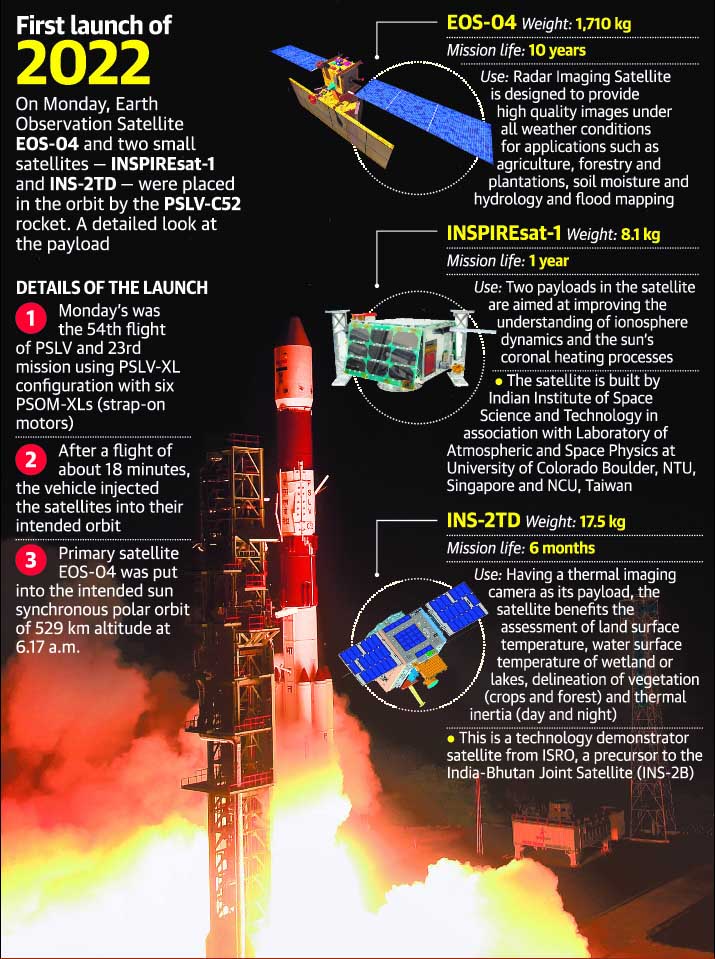Science & Technology
Earth Observation Satellite EOS-04
- 15 Feb 2022
- 5 min read
For Prelims: Indian Space Research Organisation, earth observation satellite, EOS-04, PSLV, Cartosat, RISAT-2B , SSLV (Small Satellite Launch Vehicle), EOS-03, RISAT-1, India-Bhutan Joint Satellite (INS-2B).
For Mains: Achievements of Indians in Science & Technology, ISRO and its achievements, current issues with ISRO.
Why in News?
Recently, Indian Space Research Organisation's earth observation satellite EOS-04 and two small satellites (INSPIREsat-1 and INS-2TD) were successfully placed into the intended orbit by the PSLV-C52 rocket.
- This launch was the 54th flight of the Polar Satellite Launch Vehicle (PSLV) rocket, and the 23rd of its most powerful XL-version that has six strap-on boosters.
What are Earth Observation Satellites?
- Earth observation satellites are the satellites equipped with remote sensing technology. Earth observation is the gathering of information about Earth's physical, chemical and biological systems.
- Many earth observation satellites have been employed on sun-synchronous orbit.
- Other earth observation satellites launched by ISRO include RESOURCESAT- 2, 2A, CARTOSAT-1, 2, 2A, 2B, RISAT-1 and 2, OCEANSAT-2, Megha-Tropiques, SARAL and SCATSAT-1, INSAT-3DR, 3D, etc.
What are the Three Satellites Launched?
- EOS-04:
- EOS-04 weighing 1,710 kg and with a mission life of ten years designed to provide high quality images under all weather conditions for applications such as Agriculture, Forestry and Plantations, Soil Moisture and Hydrology and Flood mapping.
- It will complement the data from Resourcesat, Cartosat and RISAT-2B series of satellites that are already in orbit.
- The first of these newly named satellites, EOS-01, launched in November 2020, is in orbit right now. EOS-02, a micro-satellite to be flown on a new launch vehicle called SSLV (Small Satellite Launch Vehicle) is yet to be launched, while launch of EOS-03 had ended in a failure in August, 2021.
- It will be placed in a sun synchronous polar orbit of 529 km, is a radar-imaging satellite which would have made it a part of the RISAT series earlier.
- In fact, it would replace the RISAT-1 which was launched in 2012 but has been non-functional for the last few years.
- RISATs use synthetic aperture radars to produce high-resolution images of the land.
- One big advantage that radar imaging has over optical instruments is that it is unaffected by weather, cloud or fog, or the lack of sunlight.
- It can produce high-quality images in all conditions and at all times, making it suitable for surveillance.
- EOS-04 weighing 1,710 kg and with a mission life of ten years designed to provide high quality images under all weather conditions for applications such as Agriculture, Forestry and Plantations, Soil Moisture and Hydrology and Flood mapping.
- INSPIREsat-1:
- INSPIREsat-1 is part of a constellation of satellites planned under the International Space Program in Research and Education (INSPIRE) involving the Small-spacecraft Systems and Payload Centre (SSPACE) at IIST, University of Colorado (US), Nanyang Technological University (NTU), Singapore, and National Central University (NCU), Taiwan.
- Two scientific payloads on INSPIREsat-1, with a mass of 8.1 kg and mission life of one year, are aimed at improving the understanding of ionosphere (part of Earth’s upper atmosphere) dynamics and the sun's coronal heating processes.
- INS-2TD:
- INS-2TD is a technology demonstrator for the first India-Bhutan joint satellite that is scheduled to be launched in March, 2022.
- The two countries had signed a space agreement last year, and its first outcome would be the launch of BhutanSat, or INS-2B, on a PSLV rocket in March, 2022.
- The thermal imaging cameras of the INS-2TD are meant for earth observation purposes, like assessment of land and water surface temperature, and identification of forest and tree cover.
- INS-2TD is a technology demonstrator for the first India-Bhutan joint satellite that is scheduled to be launched in March, 2022.
How many satellites does India have in space?
- India currently has 53 operational satellites, of which 21 are earth observation ones and another 21 are communication-based.
- Eight are navigation satellites, while the remaining three are science satellites.





